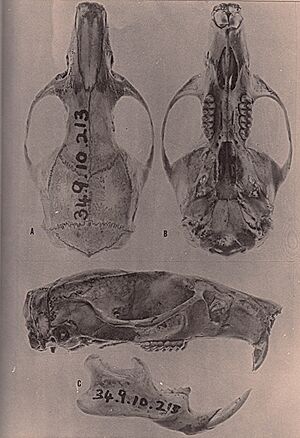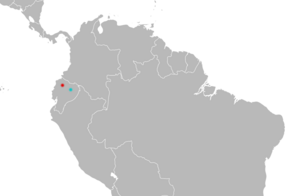Hammond's rice rat facts for kids
Quick facts for kids Hammond's rice rat |
|
|---|---|
 |
|
| Skull and mandible | |
| Conservation status | |
| Scientific classification | |
| Genus: |
Mindomys
|
| Species: |
hammondi
|
 |
|
| Distribution of Mindomys: Mindo (type locality) in red; Concepción (dubious second locality) in blue. | |
| Synonyms | |
|
|
Mindomys hammondi, also known as the Hammond's rice rat, is a type of rodent that is currently endangered. It belongs to a group of rodents called Oryzomyini, which are often called "rice rats." Scientists once thought this rat was related to other groups like Nectomys or Oryzomys. However, it is now placed in its own special group, the genus Mindomys. Its exact family tree is still a bit of a mystery.
This unique rat is only found in Ecuador, a country in South America. It lives in montane forest, which are forests found in mountains. Some people think it lives on the ground near water, while others believe it lives in trees. The Hammond's rice rat is a large rat with a very long tail and long whiskers. Its fur is a buff (yellowish-brown) color on its back and much lighter on its belly. The front part of its skull is quite strong.
The species was named after Gilbert Hammond. He was the person who first collected this rat. He also collected other animal specimens for scientists like Oldfield Thomas.
Contents
What is the Hammond's Rice Rat?
How Was it Discovered?
In 1913, a scientist named Oldfield Thomas from the British Museum of Natural History in London first described the Mindomys hammondi. He used two rats that Gilbert Hammond had collected in Mindo, Ecuador, that same year. Thomas first put this rat in the group Nectomys, calling it Nectomys hammondi. He thought it was similar to another rat, Nectomys russulus.
Later, other scientists like Sir John Ellerman and Philip Hershkovitz looked closer at the rat. They noticed that its teeth and other body parts were different from other Nectomys rats. This made them question if it truly belonged in that group.
Changing Its Classification
In 1948, Philip Hershkovitz studied the Mindomys hammondi even more. He decided it was actually a type of Oryzomys rat. He even suggested a new subgroup for it called Macruroryzomys, because of its "extremely long-tailed" feature.
Over the years, other scientists like Clayton Ray and Guy Musser also studied this rat. Some thought it might be related to Megalomys, which are giant rats from the Caribbean islands. However, its exact place in the rodent family tree remained unclear.
Why is it Called Mindomys Now?
In 2006, Marcelo Weksler did a big study of "rice rats" (Oryzomyini). He looked at both their body features and their DNA. He found that Oryzomys hammondi didn't fit well with other Oryzomys species. Some of his studies showed it might be related to tree rats called Oecomys. Others suggested it was a very early branch in the rice rat family tree.
Because of these differences, Weksler and other scientists decided to create a brand new group, or genus, for this special rat. They named it Mindomys in 2006. The name Mindomys comes from Mindo, the place in Ecuador where the rat was first found. They called it an "extraordinary rat" because of its unique features and mysterious origins.
Mindomys is now one of about 28 groups in the Oryzomyini tribe. This tribe includes over a hundred species of rats, mostly found in South America. The Oryzomyini tribe is part of a larger group called Sigmodontinae. This group has hundreds of species across North and South America. Sigmodontinae is the biggest subgroup of the Cricetidae family, which also includes voles, lemmings, and hamsters.
What Does the Hammond's Rice Rat Look Like?
The Mindomys hammondi is a large rice rat. It is bigger than most other rats found in its home area. Its fur is short and feels a bit like wool. It's yellowish-brown with a gray tint on top and much lighter, either yellow or white, underneath. The hairs are gray at their base.
This rat has a long snout and small, dark ears that look like they don't have much hair. Its vibrissae (whiskers) are very long. The tail is also very long and dark on both the top and bottom. It has small, rectangular scales. The back feet are wide with long, thin toes.
Skull Features
The skull of the Mindomys hammondi has a strong, large front part called the rostrum. The nasal bones at the front are short. The part of the skull between the eyes is narrowest at the front. Older rats often have ridges on their long braincase. The parietal bones, which form part of the top of the braincase, also extend to the sides.
Inside the mouth, there are small holes in the palate (roof of the mouth) called incisive foramina. These holes are short and don't reach between the molars. The palate itself is moderately long.
Teeth and Jaw
The molars (back teeth) of the Mindomys hammondi are low-crowned and have rounded bumps. They also have many extra ridges. Unlike some other rats, the first upper and lower molars usually don't have extra roots. Each of the three upper molars has two roots on the outside and one on the inside. Each lower molar has one root at the front and one at the back.
In the lower jaw (mandible), there's an opening called the mental foramen. It opens to the outside. The chewing muscles attach to ridges on the jaw, which join below the first molar.
Where Does it Live and What Does it Do?
The Mindomys hammondi is a rare animal. It has only been found in Ecuador. Between 1913 and 1980, eight rats were collected in Mindo, a small farming town in the mountains of northwestern Ecuador. Mindo is about 1,264 meters (4,147 feet) above sea level.
There is one record of a rat being collected in Concepción, a place in the Amazon basin lowlands. This area is much lower, about 300 to 500 meters (984 to 1,640 feet) above sea level. However, scientists are not sure if this record is correct. Other collectors have not found Mindomys in that area. Also, the date it was supposedly collected doesn't match when the collectors were there. There are other places named "Concepción" in northwestern Ecuador, so the rat might have come from one of those. Another rat was found in Chaco, at an altitude of 630 meters (2,067 feet).
The Mindomys hammondi lives in moist, mountain forests on the western side of the Andes mountains. It prefers forests that are well-preserved and untouched.
Scientists don't know much about the daily life of Mindomys. Some believe it lives in trees because of its wide feet. Others think it lives on the ground and is connected to water. It is likely active at night (nocturnal) and lives alone. It probably eats fruits, seeds, and insects.
Why is it Endangered?
The Mindomys hammondi is listed as "endangered" by the IUCN Red List. This means it is at a very high risk of becoming extinct in the wild. It is endangered because it lives in a very small area. Also, its habitat (the place where it lives) is shrinking and getting worse.
Up to 40% of its forest home may have already been destroyed. The last time this rat was officially seen was in 1980. It is not known to live in any protected areas. However, it has been found close to the protected forest of Mindo-Nambillo. Protecting its forest home is very important for its survival.


